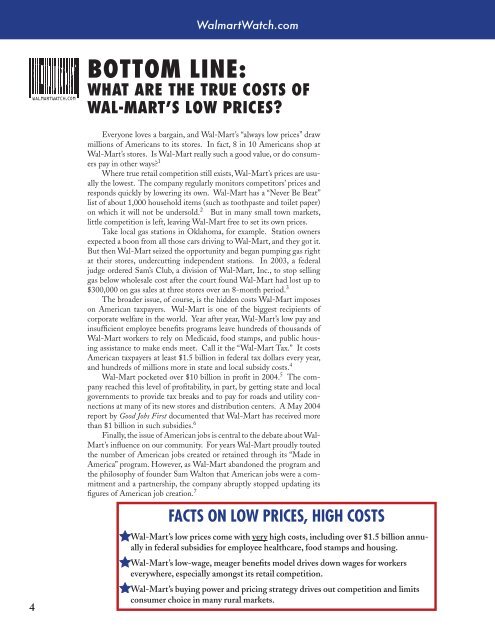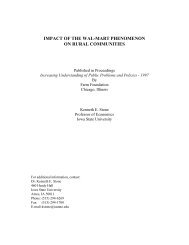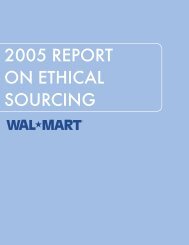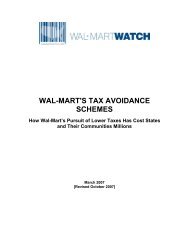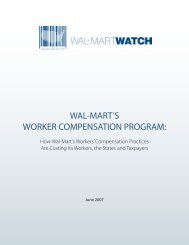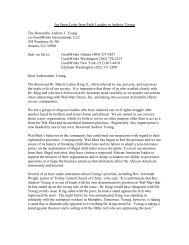WAL-MART WATCH - Making Change at Walmart
WAL-MART WATCH - Making Change at Walmart
WAL-MART WATCH - Making Change at Walmart
- No tags were found...
Create successful ePaper yourself
Turn your PDF publications into a flip-book with our unique Google optimized e-Paper software.
<strong>Walmart</strong>W<strong>at</strong>ch.comBOTTOM LINE:WHAT ARE THE TRUE COSTS OF<strong>WAL</strong>-<strong>MART</strong>’S LOW PRICES?4Everyone loves a bargain, and Wal-Mart’s “always low prices” drawmillions of Americans to its stores. In fact, 8 in 10 Americans shop <strong>at</strong>Wal-Mart’s stores. Is Wal-Mart really such a good value, or do consumerspay in other ways? 1Where true retail competition still exists, Wal-Mart’s prices are usuallythe lowest. The company regularly monitors competitors’ prices andresponds quickly by lowering its own. Wal-Mart has a “Never Be Be<strong>at</strong>”list of about 1,000 household items (such as toothpaste and toilet paper)on which it will not be undersold. 2 But in many small town markets,little competition is left, leaving Wal-Mart free to set its own prices.Take local gas st<strong>at</strong>ions in Oklahoma, for example. St<strong>at</strong>ion ownersexpected a boon from all those cars driving to Wal-Mart, and they got it.But then Wal-Mart seized the opportunity and began pumping gas right<strong>at</strong> their stores, undercutting independent st<strong>at</strong>ions. In 2003, a federaljudge ordered Sam’s Club, a division of Wal-Mart, Inc., to stop sellinggas below wholesale cost after the court found Wal-Mart had lost up to$300,000 on gas sales <strong>at</strong> three stores over an 8-month period. 3The broader issue, of course, is the hidden costs Wal-Mart imposeson American taxpayers. Wal-Mart is one of the biggest recipients ofcorpor<strong>at</strong>e welfare in the world. Year after year, Wal-Mart’s low pay andinsufficient employee benefits programs leave hundreds of thousands ofWal-Mart workers to rely on Medicaid, food stamps, and public housingassistance to make ends meet. Call it the “Wal-Mart Tax.” It costsAmerican taxpayers <strong>at</strong> least $1.5 billion in federal tax dollars every year,and hundreds of millions more in st<strong>at</strong>e and local subsidy costs. 4Wal-Mart pocketed over $10 billion in profit in 2004. 5 The companyreached this level of profitability, in part, by getting st<strong>at</strong>e and localgovernments to provide tax breaks and to pay for roads and utility connections<strong>at</strong> many of its new stores and distribution centers. A May 2004report by Good Jobs First documented th<strong>at</strong> Wal-Mart has received morethan $1 billion in such subsidies. 6Finally, the issue of American jobs is central to the deb<strong>at</strong>e about Wal-Mart’s influence on our community. For years Wal-Mart proudly toutedthe number of American jobs cre<strong>at</strong>ed or retained through its “Made inAmerica” program. However, as Wal-Mart abandoned the program andthe philosophy of founder Sam Walton th<strong>at</strong> American jobs were a commitmentand a partnership, the company abruptly stopped upd<strong>at</strong>ing itsfigures of American job cre<strong>at</strong>ion. 7FACTS ON LOW PRICES, HIGH COSTSWal-Mart’s low prices come with very high costs, including over $1.5 billion annuallyin federal subsidies for employee healthcare, food stamps and housing.Wal-Mart’s low-wage, meager benefits model drives down wages for workerseverywhere, especially amongst its retail competition.Wal-Mart’s buying power and pricing str<strong>at</strong>egy drives out competition and limitsconsumer choice in many rural markets.


